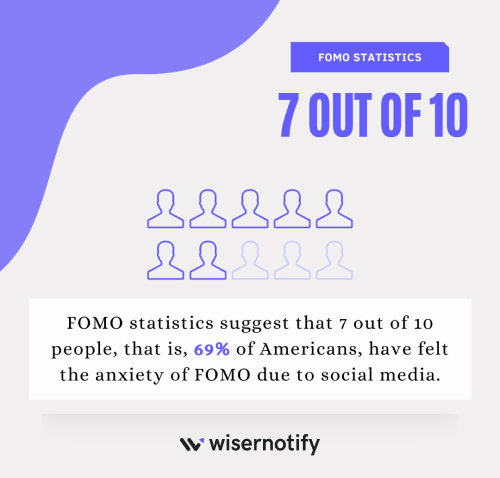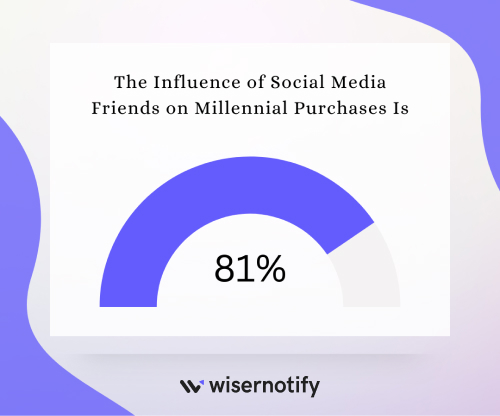FOMO influences more than half of consumers, 69% to be precise. Not only that, FOMO also brings 60% more sales.
These are pretty big numbers.
With the increase in social media usage, a lot of people feel missed out and lost on opportunities and experiences.
But that is the point where businesses should move forward.
As of 2025, there have been several places where FOMO plays an important role and has been impactful.
This series of FOMO statistics will provide critical insights into the latest trends and provide a way for businesses to benefit from FOMO.
Build trust & FOMO
Highlight real-time activities like reviews, sales & sign-ups.
Top FOMO Statistics
Almost 40% drive themselves into debt while trying to keep up with their social groups.
37% of people have made a purchase after constant exposure to social media.
About 69% of millennials experience FOMO regularly.
26% of social media users experiencing FOMO are scared of losing friends.
55% of people spend their money on live events such as concerts.
The number of US outbound flights increased by about 97% due to summer FOMO.
Major FOMO Statistics
FOMO statistics are a powerful way to increase business revenue.
1. According to some statistics, marketing drives 60% of sales, all due to FOMO.

Understanding FOMO statistics can also help businesses develop effective marketing strategies to attract customers.
By understanding these statistics, businesses can use or create FOMO to influence social media usage, drive sales, increase engagement, and encourage users to stay on platforms longer and, thus, stay ahead in the market.
2. Around 14% of people have a ‘major’ fear of missing out on opportunities like the best price and also have FOMO on social events and job opportunities.
3. It has been noticed that 71% of consumers are more likely to make purchases based on social media referrals.

This just proves that they are highly influenced by social media and would most probably try to experience it themselves.
4. More than half of people, around 56% are worried about missing important events, news, and social updates if they’re away from social media accounts, according to research on FOMO marketing.
Studies show that around 8 in 10 teenagers say that what they see on social media makes them feel more connected to their friends, and without it, they will feel excluded from their friends’ lives.
Fear of social exclusion can also turn out to be a significant factor in motivating consumers.
5. Around 40% go into debt while trying to keep up with their friends
6. According to a FOMO statistics report by Credit Karma, 40% of people, especially those belonging to Gen Z, overspend in certain situations and end up in debt only to match up with their peers.
This shows that FOMO can even influence financial decisions and human behavior.
7. More than 35% of online shoppers admit to being influenced by exclusive deals.
This means that the strategy of creating scarcity and exclusivity can enhance or create FOMO.
Similarly, limited-time deals can also be a huge factor in intensifying this effect and increasing FOMO marketing.
Most individuals experiencing FOMO have negative emotions
8. While experiencing FOMO, people predominantly report negative emotions. 30% have shown jealousy, 21% have shown sadness or disappointment.

9. Only a minority of 29% have shown happiness, which indicates that FOMO is an uncomfortable emotion.
Also see: 10 Powerful FOMO Marketing Examples You Need to See
Build trust & FOMO
Highlight real-time activities like reviews, sales & sign-ups.
What Percentage of People Make Purchases Due to FOMO?
10. Around 60% of consumers make a reactive purchase within 24 hours after experiencing FOMO.
11. 76% of people admit to making a purchase across all platforms or after seeing it on social media due to FOMO.

Constant exposure to social media can influence purchase decisions
12. A study by GlobalWebIndex found that 37% of social media users have made purchases due to Fear of missing out.
Social media platforms play a crucial role in increasing FOMO among people. The constant exposure of products can drive people to purchase them quickly.
13. 41% of millennials are prone to making quick transactions on mobile purchases due to FOMO.

FOMO Statistics: Gen Z and Millennials
14. 69% of millennials experience FOMO regularly
Around 69% of millennials experience FOMO regularly and end up making purchases to avoid missing out on experiences they see on social media.
People are influenced by their families and friends and try to recreate the experience, hoping it will be rewarding for them as well.
15. 67% of millennials experience FOMO due to social media, and 35% of them say that they post solely because they’re scared of missing out.

16. 73% of millennials said that they spent money, which they didn’t even have since they didn’t want to be left out.
Build trust & FOMO
Highlight real-time activities like reviews, sales & sign-ups.
FOMO & Social Media: Percentage of Users Affected
17. Among social media networks, Facebook contributes 72% to people’s FOMO fear, which is the most. Instagram comes second with 14%, Twitter with 11%, and Pinterest with 8%.
18. FOMO statistics suggest that 7 out of 10 people, that is, 69% of Americans, have felt the anxiety of FOMO due to social media.

Factors like events, updates by family and friends, and experiences shared by everyone can make you feel left out.
Social media shows the lives of others, creating unrealistic comparisons in your mind and leaving you feeling unsatisfied.
19. FOMO leads about 51% of people to use social media more often than they did two years ago.
20. 48% of people say that social media makes them feel like they are missing out on experiences.
Must Read: FOMO Notifications Popup (Examples + Tactics + Tools)
FOMO’s Impact on Consumer Behavior
21. 36% of people are afraid to feel like an outsider due to the fear of being left out and would like to have the same experiences as others.
22. 26% of social media users are scared of losing friends
A significant 26% of global internet users who experience FOMO are scared of losing friends, while 23% worry about being judged.
This shows that FOMO is not just driven by material or experiences but also the fear of social exclusion and rejection.
23. 20% of people cannot even go more than an hour without checking social media, and 45% experiencing FOMO cannot wait longer than 12 hours.
24. 81% of millennials are influenced by their friends’ posts on social media by quickly making purchases.

FOMO’s Influence on Spending Habits
25. 55% of users spend money on live events
FOMO statistics suggest that around 55% of people spend money on live events, such as concerts, which are some of the biggest social events.
Moreover, a study shows that FOMO influences nearly half of millennials who attend live events to have something to post about later and not feel left out.
26. 41% of people spend money on events or gatherings only because they are worried about not being able to be invited again in the future.

27. 69% of people attend social or live events only to strengthen their connections with other people.
The topmost things that create FOMO are travel, which is among 59%; parties and events, among 56%; and food, 29%.
US outbound flights increased over the span of one year
28. According to US travel statistics, from April 2021 to April 2022, the number of outbound flights increased about 97%.
Also, the number of Airbnb stays increased after May 2022. All this was a result of FOMO, possibly due to the COVID-19 pandemic.
Checkout: 10 Best FOMO Tools in 2025 to Create Urgency
FOMO Trends to Watch
Social Media Evolution
Social media will have advanced algorithms with AI personalization, which will keep consumers constantly exposed to content that will show them what they’ve been missing out on.
In 2023, social media ad spending was approximately 270 billion dollars,270 billion dollars which is expected to surpass the 300 billion mark by the end of 2025.
Exclusive content and Membership
With the increase in subscription-based products, people are already seen as having the need to experience it all.
This will raise their value, and the rate of premium content consumption will increase.
The global subscription e-commerce market is expected to grow from $34.7 billion in 2020 to $2643.6 billion by 2028.
Retail
It is possible that physical retail stores or local businesses will also evolve and provide unique experiences like lessening the time of checkout and enhancing brand loyalty
78% of millennials prefer spending money on experiences over things.
Wrap up
The data is clear: FOMO isn’t just a buzzword; it’s a powerful psychological force that’s shaping consumer behavior in 2025.
Whether it’s the fear of missing out on the latest product drop, an exclusive event, or simply staying in the loop with social trends, FOMO has undeniable influence.
Sources








